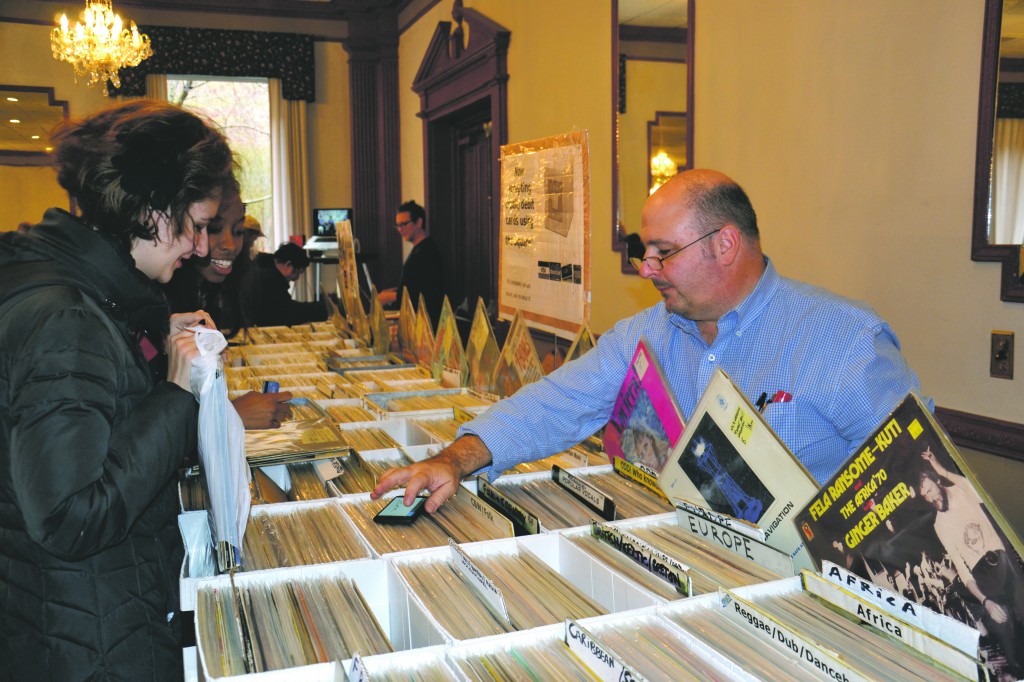
Upon entering the Days Inn on Front Street, I immediately noticed the makeup of the moderately sized crowd: mainly older men, with a smattering of predominantly male 20-somethings and families of three, perhaps looking for something to do on an idle Sunday afternoon. Vinyl’s resurgence as a listening format is spoken of less today than in the recent past, perhaps due to the rise of streaming digital audio services like Spotify.
Still, for many people passionate about music, the physical presence of a record makes it preferable to MP3 files. This appeared to be the main sticking point with the attendees I talked to, even over the alleged superiority of analog audio quality to digital. For some, this is a moot point. Ray Futia, the news director for WHRW 90.5 FM and a junior majoring in biology, said that FLAC files are of comparable quality to LPs. Adam Suthard, a local resident, said that listening to records without skipping tracks has a stronger social aspect than listening to digital playlists.
Jack Skutnik is responsible for much of the fair’s organization, taking it to Binghamton, Utica, Syracuse and Ithaca in New York and Wilkes-Barre, Pa. He has been selling records for 35 years and estimates that he has between 50,000 and 60,000 records. Skutnik’s rarest record is a copy of The Beatles’ “Yesterday and Today” with the pasteboard still intact, underneath which is a bizarre photo of the four Beatles covered in raw meat and baby dolls. According to John Lennon, it was a statement against the Vietnam War. According to George Harrison, it was merely stupid and gross.
At one time, Skutnik owned one of the rarest records in existence: a picture sleeve 45 of The Rolling Stones’ “Street Fighting Man” featuring a photograph of cops beating a protester during a riot. Only about 15 of them were ever released, due to London Records’ hesitancy to release a product with such inflammatory album art. Skutnik sold his copy for $12,000.
Record vendors told me that the resurgence of vinyl is driven by 18 to 25-year-olds who came to see CDs as disposable (at one point in our conversation, Suthard said he preferred records because “CDs are easy to lose”) and felt that the impermanence of digital files interfered with their listening experience. They each asserted that classic rock tends to sell best, especially records by Pink Floyd, The Beatles, Led Zeppelin and Jimi Hendrix. Indeed, the majority of students I talked to were purchasing records made by ’60s and ’70s rock acts.
I would say the prices were more or less what I’m used to at record shops and fairs I’ve attended in other parts of New York — that is, just slightly above what I’m willing to pay. There wasn’t much variation in price across the booths; the average price for a used record was $10, with some of the more well-known records going as high as $45. Aside from records, the fair also had memorabilia for sale, including Kiss dolls, the album cover to Ghostface Killah’s “Ironman” in puzzle format, a signed Joan Jett poster, DVDs of rock concerts, including a curiously titled compilation of Frank Zappa TV appearances from the ’60s, and used CDs, including bootleg ones of Bob Dylan live performances from 1978-81 packaged in what looked like a pink lunchbox. Those who came for rock records, which made up the majority of the selection, tended to be pleased. Though I didn’t purchase anything, it’s always a pleasure to sift through a stack of records along with other music obsessives — and far more satisfying than scrolling through someone’s iTunes library.


